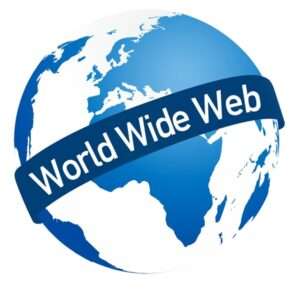The full form of WWW is the World Wide Web. WWW is also called a Web and it is a catalogue of an order of all websites connected to the worldwide Internet. It is an information system in which linked hypertext data and resources are accessed over the Internet. Using a web browser, a user can access a web page and a user can navigate between the web pages using hyperlinks where images, texts, and other multimedia data and content can be carried on a website page.



History of the World Wide Web
- Pre-Web Internet (1960s-1980s): The Internet was a text-based network for academics and researchers.
- Tim Berners-Lee’s Proposal (1989): Tim Berners-Lee conceived the web, proposing a “distributed information system” at CERN.
- First Website and Browser (1990): Berners-Lee created the first website and web browser.
- First Web Server (1990): The first web server marked the birth of the web.
- Public Release (1993): CERN made the web’s technology freely accessible.
- Mosaic Browser (1993): Mosaic popularized the web with text and images.
- HTML and URL Standards (1994-1995): W3C standardized HTML and URLs.
- Browser Wars (1990s): Browser competition accelerated web development.
- Dot-Com Bubble (late 1990s): Internet companies boomed and busted.
- Web 2.0 (early 2000s): User-generated content and social media emerged.
- Mobile Web (the 2000s): Smartphones led to the mobile-optimized web.
- Modern Web (2010s-Present): HTML5 and complex web development.
- Web 3.0 and the Future: Focus on blockchain and semantic web.
How the World Wide Web Works
- Client-Server Model: Users (clients) access websites hosted on powerful computers (servers).
- Web Browser: Users use web browsers to view web content by entering URLs.
- DNS: Domain names are translated into IP addresses by the DNS system.
- HTTP Request: Browsers send HTTP requests to web servers, specifying the desired resource.
- Web Server: Servers process requests, retrieve webpages, and may access databases.
- Webpage Compilation: Web servers compile webpages with HTML, CSS, JavaScript, and multimedia.
- HTTP Response: Servers send HTTP responses containing requested content.
- Rendering: Browsers interpret HTML, and CSS, and execute JavaScript to display webpages.
- Hyperlinks: Clicking links initiates new HTTP requests for linked content.
- Cookies and Sessions: Data storage for user interactions and personalization.
- Encryption: Secure HTTPS protects data during transmission.
- CDNs: Content Delivery Networks improve website speed and reliability.
- Search Engines: Index web content for fast and relevant search results.
- Web Hosting: Websites stored on web servers are made accessible online.
Web Development Technologies
- HTML: Structures web content.
- CSS: Styles and formats web content.
- JavaScript: Adds interactivity and dynamic features.
- Front-End Frameworks: Tools like React, Angular, and Vue.js for efficient front-end development.
- Back-End Languages: Node.js, Python (Django/Flask), Ruby (Ruby on Rails), PHP, and Java for server-side logic.
- Web Servers: Apache, Nginx, and IIS serve web content.
- Databases: MySQL, PostgreSQL, MongoDB, and others for data storage.
- APIs: Enable data exchange and integration with other services.
- Version Control: Git for code tracking and collaboration.
- Development Tools: Editors, package managers, and build tools streamline development.
- Hosting and Deployment: AWS, Azure, Heroku, etc., for deploying web applications.
- Responsive Design: Creating websites for various screen sizes.
- Web Accessibility: Ensures websites are usable by everyone.
- Security: Protects against vulnerabilities and threats.
- Content Management Systems (CMS): WordPress, Drupal, and Joomla for content-driven sites.
- Progressive Web Apps (PWAs): Deliver native app-like experiences in browsers.
- Serverless Computing: Simplifies server management.
Web Content and Multimedia
- Text Content: Words and sentences that explain things, like titles, paragraphs, lists, and links.
- Images: Pictures that make websites look nice and show things like products, logos, or data in an easy-to-understand way.
- Videos: Moving pictures that can be shown on websites, like videos you see on YouTube.
- Audio: Sounds, like music or spoken words, that can be played on websites.
- Interactive Stuff: Things that you can click on or move around, like games, animations, or interactive maps.
- Fancy Text: Special types of letters and styles that make text look interesting.
- Moving Things: Cool effects like smooth transitions and moving parts on a website.
- Documents: Files like PDFs that can be seen on the web.
- Fonts: Special letter designs to make text look unique.
- Accessibility: Making sure that people with disabilities can understand and use everything on a website.
Conclusion
In conclusion, the World Wide Web (WWW) stands as one of the most transformative inventions of the digital age. From its humble beginnings as a suggestion through Tim Berners-Lee in 1989, it has grown into a worldwide network that connects people, organizations, and companies globally.
The WWW has democratized get admission to to information, revolutionized conversation, and fostered innovation throughout limitless industries. Its middle technologies, such as HTML, CSS, and JavaScript, have enabled the introduction of dynamic and interactive net stories.
Frequently Asked Question
The World Wide Web was invented by British computer scientist Tim Berners-Lee in 1989 while he was working at CERN, the European Particle Physics Laboratory, in Switzerland.
The WWW operates on a client-server model, where web browsers (clients) request and display web content from web servers. The content is transmitted using protocols like HTTP (Hypertext Transfer Protocol).
HTML (Hypertext Markup Language), CSS (Cascading Style Sheets), and JavaScript are the fundamental technologies for creating web content. These technologies structure, style, and add interactivity to web pages.






